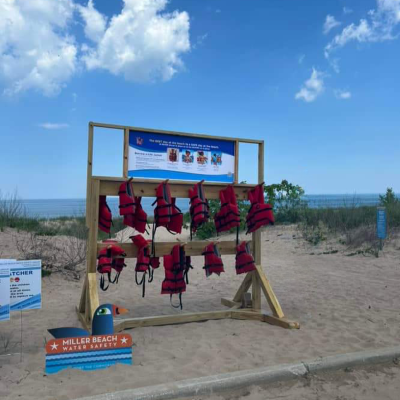Thanks to the combined efforts of private citizens and volunteers including faculty member Bill Ramos, Ph.D., Miller Beach in Gary, Indiana has introduced its first community lifejacket lending station. The station, the first of its kind on an Indiana bathing beach on Lake Michigan—was fully privately funded by a group of concerned citizens.
“It’s a great concept and we don’t do much of it in Indiana,” says Dr. Ramos, associate professor in the Department of Health & Wellness Design. “Not only is it great for functionality but it is a good social experiment as this is just something left out for people to use.”
Dr. Ramos, who hails from Gary, is one of eight members of the Executive Committee of the Water Safety Social Group that, along with volunteers, raised private funding to install the station last month. The organization is part of the 501(c)-designated Friends of Marquette Park and Legacy Foundation. With nationwide drowning deaths on the rise once again, this concerned community took matters into their own hands.
“I always tell people my heart is still there and it was my first exposure to aquatic management and safety,” shares Dr. Ramos. “I sit on the Water Safety Social Group board as part of my service commitments to the university and I love this one because it hits the pillar that we have now of the IU Bloomington 2030 goal of connecting with the state and also giving back to the community—but it is also my hometown.”
Dr. Ramos says this organization has been a prime example of private citizens trailblazing water safety for the state of Indiana, installing 25 safety stations that include a ring, rope, lifejacket, and instructions along the five miles of Miller Beach—long before it went into law to do so. According to Executive Committee Chairperson Paula Rooney, the safety stations will be upgraded with an additional life ring and 100 feet of rope, per Indiana Senate Bill 253 that passed on March 11 of this year.
Rooney says the semi-permanent lifejacket station (open from dawn to dusk every day) was durably built by committee member Tom Rooney over the course of several months after the program and installation was approved by the Gary Park Board in April 2023. More than $3,000 of private funds were raised to make the station a reality, some of which are being kept in reserve to replenish any jackets that get damaged or go missing. The station is stocked with Coast Guard–approved jackets in sizes ranging from infant to adult oversize and offers instructions on how to use them, where to return them, and a QR code that can be scanned with a smartphone providing additional water safety information.
“There exist a variety of [station] designs across the country, some as simple as a hat rack, other versions closer to a shed on a concrete pad with a roof and locking shutters,” says Paula Rooney. “We decided on a handful of requirements including a capacity of 20 jackets, large clear signage, and the ability to move the rack as needed on sand or hard surface.”
Rooney says they started out with 21 jackets and while four have recently gone missing, it appears the station is getting regular traffic—and sincere appreciation from the community.

“Every few days someone goes to check on things and straighten up and it appears the jackets are getting regular use. We know because many are sandy but also because the buckles are undone,” says Rooney. “One man even stated it brought a tear to his eye before asking his companion to take a picture of him next to the rack.”
While Dr. Ramos acknowledges that having something completely accessible lends itself to product loss, fewer barriers to accessibility means greater use of the safety resources—most critically at night.
“It just gives people that extra layer of protection they may have not thought to bring with them,” says Dr. Ramos. “People often relate lifejackets to boating but don’t relate them to just entering bodies of water, but they are the great equalizer that gives you a little more time, the buoyancy you need if you aren’t strong swimmer.”
The Water Safety Social Group is in talks about adding another lifejacket lending station at the Lake Street boat launch location if the current one continues to be well used.
“[The lifejackets] just take another level of risk out of the experience,” says Dr. Ramos. “I just want everyone to enjoy the water, have it in their life, and pass that joy on.”
For more stories about SPH-B students, faculty and staff making an impact locally and worldwide, visit go.iu.edu/48bx.


